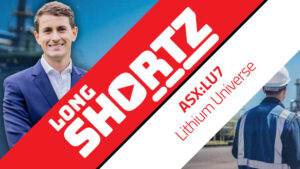After a historic bull run last year, Sprott says the uranium price has steadied to between $85 and $95
Sprott reckons its a natural correction within the broader context of a bullish market cycle
This provides explorers with certainty to make investment decisions and development plans
Sprott Asset Management, one of the most influential junior mining investment firms in the world, says the uranium price has stabilised between $85 to $95 per pound after an 88.54% surge in 2023.
From the lows of US$18/lb in 2018, prices more than doubled between January 2023 to 2024 and hit a 16-year high of US$107/lb, breaking away from the Fukushima shaped prison that swamped the nuclear energy space for decades.
In its latest research note, Sprott says the uranium spot price has largely been in a consolidation phase over the past few months while uranium miners play catch up to the commodity’s gains.
“We believe a natural correction within the broader context of a bullish market cycle is a healthy sign of a functioning market,” Sprott ETF product manager Jacob White says.
“Besides being a pause in the longer-term bull run, the uranium spot market has been susceptible to broader factors like broader commodities weakness, seasonal softness and a lack of expected buying activity with the passage of the Prohibiting Russian Uranium Imports Act.”
On the flip side, the asset manager founded by legendary Canadian mining investor Eric Sprott says fundamentals continue to strengthen with nuclear power plant restarts, new builds and a deepening supply deficit that sees global demand reaching 209Mlb annually by 2035.
Supply will fall short at 114Mlb, a little over 54% of end user demand. Already contracts are being drawn with higher ceilings and floors, with long term prices of US$77/lb in May regarded as the highest in over 15 years.
“Contracts now include higher ceilings ($110 to $130 per pound) and floors (mid $60s to low $70s), benefiting miners in securing better terms,” White said.
With no meaningful new supply on the horizon for three to five years, Sprott reckons this bull market has more room to run.
How does this impact ASX explorers?
The stabilised spot price provides explorers with reasonable certainty for investment decisions.
It incentivises companies to carry out exploration plans, prove up resources, and get on with other aspects of development at their respective uranium projects.
That’s true for companies like Alligator Energy (ASX:AGE) who are working towards a big resource upgrade at the Samphire in-situ recovery (ISR) uranium project in South Australia.
An exploration target of 14-75Mlb of contained uranium covers just 42% of the project’s known paleochannels, proving there’s ample opportunity for growth.
With a current resource of 12.4Mt at 640ppm uranium oxide for 17.5Mlbs of contained uranium, a resource extension drilling program is underway to increase the potential annual production rate at the site in an upcoming feasibility study.
Explorers plucking away at exploration programs
South Australia, home to 25% of the world’s uranium as well as the largest uranium deposit globally, BHP’s Olympic Dam, is considered Australia’s premier uranium jurisdiction and is renowned for being proactive in uranium development.
No wonder resources companies in the state are kicking off exploration programs on the back of higher prices.
Marmota (ASX:MEU) is one of them, with its Junction Dam project only 15km west of Boss Energy’s (ASX:BOE) Honeymoon asset, which recently produced its first drum of uranium.
The stock is awaiting approvals to start drilling so that it can investigate the presence of two uranium systems of different ages at the Bridget target, along with what appears to be a 20m high stacked uranium roll front.
With an exploration target of 22-33Mlb at 400-700ppm U308, as well an inferred resource of 5.4Mlbs U308 at a grade of 557ppm at the Saffron deposit, MEU’s goal is to substantially grow the existing uranium resource at Saffron and then grow the Junction Dam resource further by bringing in the Bridget and Yolanda uranium deposits which are not yet included in the project’s resource.
Up in Australia’s top end, DevEx (ASX:DEV) recently expanded its district-scale footprint of the Murthy West uranium project after entering into an earn-in agreement with Trek Metals (ASX:TKM).
The deal consolidates DEV’s prospective tenure along the southern margin of the McArthur Basin and to the west of the Westmoreland uranium project, while providing the opportunity for the company to earn an 80% interest in the tenements once granted.
Africa’s uranium potential
Over in Africa, foreign investor interest is pouring into unexploited uranium-rich deposits as the world continues to shift away from fossil fuels.
According to Elevate Uranium (ASX:EL8) managing director Murray Hill, nuclear power is growing in acceptance in Namibia, the continent’s biggest producer and the world’s third largest.
Currently, EL8 is progressing its Koppies uranium project with the collection of bulk samples for metallurgical testwork.
These samples will be used to test the company’s proprietary U-pgrade beneficiation process, which can concentrate uranium by rejecting more than 95% of the non-uranium bearing mass.
Results from the program will then be used to design the pilot plant.
Further north in Mauritania, Aura Energy (ASX:AEE) has been busy increasing its resources at the Tiris project by 55% to 91.3Mlbs uranium, up from 58.9Mlbs.
The boost, thanks to a recent 15,262m drill program which delivered a 28.9 Mlbs U308 increase in the Tiris East mineral resource, was delivered at a discovery cost of only US$ 0.14 per lb U3O8.
That means means there’s potential to materially enhance the project’s already impressive FEED economics of NPV8 US$388m and IRR 36% after tax.
Lotus Resources (ASX:LOT) is another African play but with uranium assets in Botswana (Letlhakane) and Malawi (Kayelekera).
Kayelekera is set to restart uranium production in late 2025 – when the supply gap for nuclear facilities is likely to emerge – in a bid to benefit from improving uranium prices.
This target date will depend on several conditions being met as well as the successful conclusion of various actions before or as part of a final investment decision, the company said in a statement in January.
At Stockhead we tell it like it is. While Aura Energy, Marmota, and Elevate Uranium are Stockhead advertisers, they did not sponsor this article.
The post Sprott: Uranium correction is healthy appeared first on Stockhead.






















